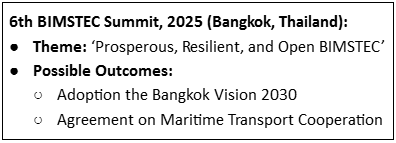Syllabus: GS2/International Relation
Context
- As India prepares for the 6th Summit of Bay of Bengal Initiative for Multi-Sectoral Technical and Economic Cooperation (BIMSTEC), its role in fostering connectivity and addressing shared challenges in the Bay of Bengal region is under scrutiny.
About the BIMSTEC
- It is a regional organization that fosters economic and technical collaboration among countries in the Bay of Bengal region.
- The Bangkok Declaration (1997) formally laid the foundation for the organization, as BIST-EC(Bangladesh, India, Sri Lanka, and Thailand Economic Cooperation).
- Myanmar joined later that year, transforming it into BIMST-EC, and Nepal and Bhutan became members in 2004, finalizing the present-day BIMSTEC.
- Since then, BIMSTEC has expanded its focus to include connectivity, counterterrorism, technology, trade, security, and people-to-people ties.

Earlier BIMSTEC Summits
- 1st BIMSTEC Summit, 2004 (Bangkok, Thailand): Strengthening economic cooperation among member countries.
- Adoption of the Bangkok Declaration, formalizing BIMSTEC as a regional group.
- 2nd BIMSTEC Summit, 2008 (New Delhi, India): Energy, transport, and trade connectivity.
- Agreement to establish the BIMSTEC Free Trade Area (FTA).
- India proposed a regional energy grid for better power-sharing.
- 3rd BIMSTEC Summit, 2014 (Nay Pyi Taw, Myanmar): Strengthening security and regional connectivity.
- Endorsement of the BIMSTEC Convention on Counter-Terrorism.
- Formation of an expert group on energy cooperation.
- 4th BIMSTEC Summit, 2018 (Kathmandu, Nepal): Strengthening institutional mechanisms and transport linkages.
- Adoption of the BIMSTEC Charter (to institutionalize the organization).
- Proposal for a BIMSTEC Development Fund.
- 5th BIMSTEC Summit, 2022 (Colombo, Sri Lanka): Post-pandemic economic recovery and security cooperation.
- Adoption of the BIMSTEC Charter (formalizing the structure of BIMSTEC).
- Establishment of 7 key sectors of cooperation like:
- Trade and Investment (Bangladesh): Strengthening economic integration and trade facilitation.
- Transport & Communication (India): Improving regional connectivity via highways, railways, and shipping.
- Energy Cooperation (Myanmar): Enhancing energy security, cross-border power trade, and renewable energy projects.
- Counterterrorism & Security; Climate Change & Disaster Management (India): Coordinating efforts against terrorism, human trafficking, and cyber threats; Addressing environmental challenges and disaster resilience.
- Technology & Innovation (Sri Lanka): Promoting research and innovation.
- Public Health (Thailand): Enhancing healthcare cooperation and pandemic preparedness.
Significance of BIMSTEC
- Boost Trade and Investment: Facilitate intra-regional trade and economic collaboration.
- Enhance Connectivity: Develop infrastructure, transport, and digital connectivity.
- Strengthen Regional Security: Cooperate on counterterrorism, cyber-security, and transnational crime.
- Sustainable Development: Address climate change, disaster management, and sustainable energy.
- People-to-People Exchanges: Promote cultural ties, tourism, and educational collaboration.
Importance of BIMSTEC for India
- Strategic Connectivity: Enhances Northeast India’s linkages with Southeast Asia.
- ‘Act East’ Policy: India plays a leading role in BIMSTEC as the largest economy in the bloc. BIMSTEC aligns with India’s ‘Act East’ policy, strengthening ties with Southeast Asian nations.
- India is actively involved in BIMSTEC-led projects such as the BBIN (Bangladesh, Bhutan, India, Nepal) Motor Vehicle Agreement, trilateral highways, and port connectivity programs.
- Economic Growth: Expands markets for Indian businesses.
- Energy Security: Facilitates regional power trade and renewable energy projects.
- Geopolitical Influence: Strengthens India’s presence in the Indo-Pacific region.
- Alternative to SAARC: Overcomes challenges posed by Pakistan in South Asian Association for Regional Cooperation (SAARC) by focusing on like-minded nations.
Major Initiatives
- BIMSTEC Free Trade Agreement (FTA): The long-pending BIMSTEC FTA aims to boost intra-regional trade.
- Negotiations focus on tariff reduction, trade facilitation, and investment flows.
- BIMSTEC Transport Connectivity Master Plan: India has proposed multi-modal transport networks linking ports, roads, railways, and air routes.
- The Kaladan Multi-Modal Transit Transport Project (India-Myanmar) and the Trilateral Highway (India-Myanmar-Thailand) are part of this initiative.
- BIMSTEC Energy Grid: Plans for a regional electricity grid to facilitate cross-border energy trade.
- India and Myanmar are leading efforts in renewable energy and power sharing.
- BIMSTEC Security Cooperation: The BIMSTEC Convention on Counter-Terrorism and Transnational Crime aims to strengthen security collaboration.
- India and Thailand are leading cybersecurity and maritime security initiatives.
- BIMSTEC Disaster Management Mechanism: Regional response frameworks for natural disasters, climate change adaptation, and humanitarian assistance.
Challenges Facing BIMSTEC
- Slow Progress on Agreements: The FTA and key connectivity projects have seen delays.
- Institutional Weaknesses: BIMSTEC lacks a permanent secretariat with sufficient funding and staffing.
- Unequal Member Commitments: Some member nations prioritize ASEAN or SAARC over BIMSTEC.
- China’s Growing Influence: Chinese investments in Myanmar, Bangladesh, and Thailand pose strategic challenges for India.
- Geopolitical Issues: Border tensions (e.g., India-Myanmar) and internal instability (Myanmar’s political crisis) affect cooperation.
Way Forward
- Accelerating FTA negotiations to enhance regional trade.
- Boosting connectivity projects for better economic integration.
- Institutional Strengthening – Establishing a fully operational BIMSTEC Secretariat.
- Enhancing security cooperation on terrorism, cyber threats, and transnational crimes.
- Increasing investment in infrastructure and digital trade.
- India, as the regional leader, must prioritize BIMSTEC in its foreign policy by investing in capacity-building, trade facilitation, and technological collaboration.
Conclusion
- BIMSTEC holds immense potential as a regional economic and strategic bloc, bridging South Asia and Southeast Asia.
- With India’s leadership and enhanced cooperation among members, BIMSTEC can emerge as a key driver of regional growth, connectivity, and security.
- However, it requires stronger political will, infrastructure development, and institutional reforms to achieve its full potential.
- If implemented effectively, BIMSTEC could redefine regional diplomacy and economic partnerships in the Bay of Bengal region.
| Daily Mains Practice Question [Q] How does India’s proactive role in the BIMSTEC framework reflect its strategic vision for regional integration and its response to geopolitical challenges in the Bay of Bengal region? |
Previous article
NEP 2020 in the Classroom: From Policy to Practice
Next article
Digital Child Abuse: Danger of AI-Based Exploitation